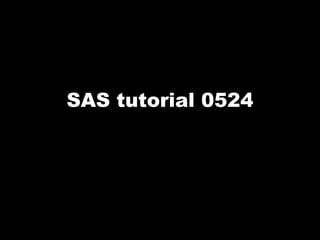Sas tutorial 0524
- 2. proc anova; class A B S; model y=S|A|B; test h=A e= S*A; run; The same as glm Ł¨µ«ĘDZČÝ^›]ÓĂ...Ł©
- 3. Example title 'Unbalanced Two-Way 2 1 28 . 23 34 42 13 Analysis of Variance'; 2 2 . 34 33 31 . 36 data a; 2 3 3 26 28 32 4 16 input drug disease @; 3 1 . . 1 29 . 19 do i=1 to 6; 3 2 . 11 9 7 1 -6 input y @; 3 3 21 1 . 9 3 . output; 4 1 24 . 9 22 -2 15 end; 4 2 27 12 12 -5 16 15 datalines; 4 3 22 7 25 5 12 . 1 1 42 44 36 13 19 22 ; 1 2 33 . 26 . 33 21 1 3 31 -3 . 25 25 24
- 4. 4x3 2-way
- 5. code ods graphics on; proc glm; class drug disease; model y=drug disease drug*disease /ss3; contrast 'drug 1 vs 2' drug 1 -1 0 0; contrast 'drug 1 vs 3' drug 1 0 -1 0; contrast 'drug 1 vs 4' drug 1 0 0 -1; lsmeans drug/ pdiff=all adjust=tukey; run; ods graphics off;
- 6. Result
- 10. Dummy variable ? Category variable ? Set reference group ? Set N-1 d.variables: ¨C 1 if xij belongs to the group specified ¨C 0 if xij belongs to other groups ? E.g. variable drug in the example: ¨C 0 0 0 => drug=1 ¨C 1 0 0 => drug=2 ¨C 0 1 0 => drug=3 ¨C 0 0 1 => drug=4
- 11. Data
- 12. Result (is the same)
- 13. Why use d.v. coding? http://www.sas.com/offices/NA/canada/downloads/presen tations/VancouverMay11/Variable.pdf
- 15. If you cannot run contrast analysis©¤©¤ ? Check coefficients ? Separate main effects and interactions into different models. ? e.g. 2-way ANOVA with interaction: ¨C model y = A B; (contrasts for main effects) ¨C model y = A*B; (contrasts for interaction)


![proc anova;
class A B S;
model y=S|A|B;
test h=A e= S*A;
run;
The same as glm Ł¨µ«ĘDZČÝ^›]ÓĂ...Ł©](https://image.slidesharecdn.com/sastutorial0524-120523232730-phpapp02/85/Sas-tutorial-0524-2-320.jpg)












